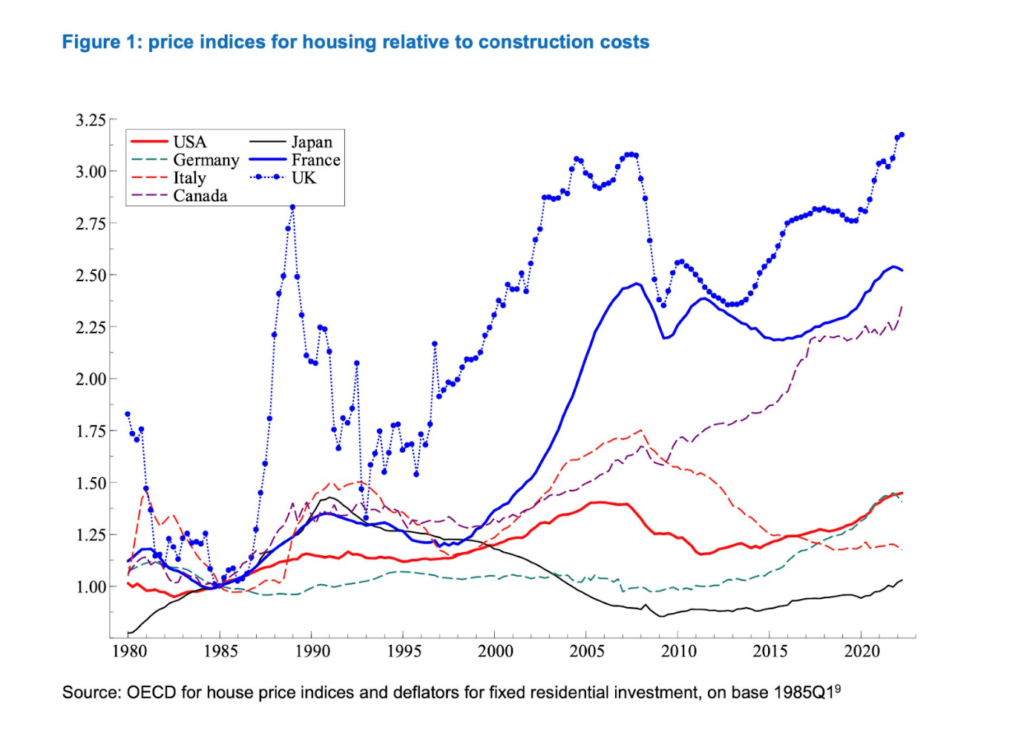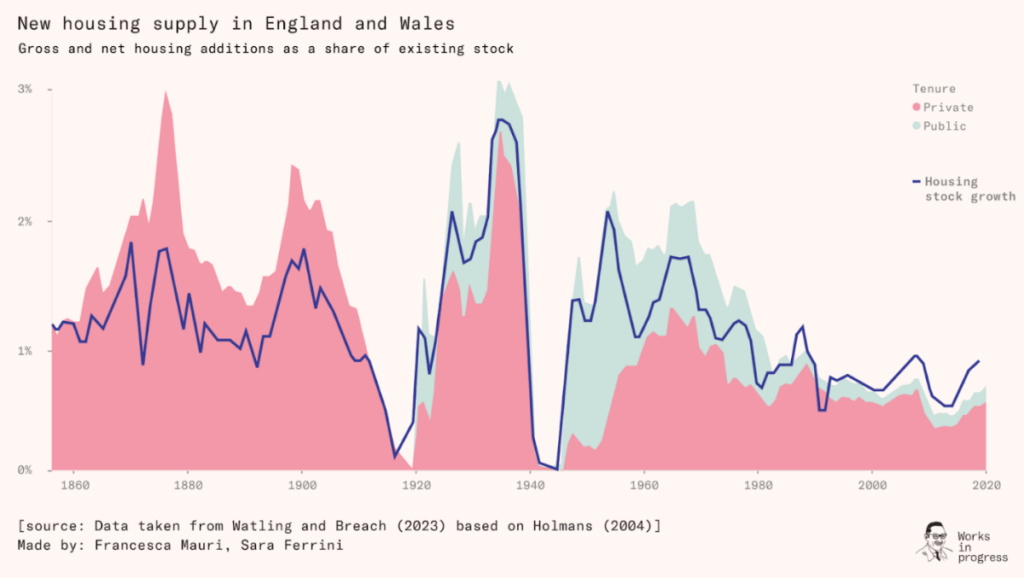
In fact, in 2020, land was the most valuable asset in the economy, valued by the ONS at £6.3 trillion. Land underlying dwellings was valued at £5.4 trillion. Of course, that land would not have most of that value if it were in undeveloped use, such as for agriculture. Farmland and gardens are cheap. Most of the £5.4 trillion is attributable to the value of the planning permissions in respect of the housing already on the land. Planning permissions need have no intrinsic value. It is only because they are scarce that they are worth so much.
There is strong evidence that this regulatory wedge causes large welfare losses. In places like Atlanta where there are no binding supply constraints, prices of homes tend to remain close to the economic cost of building more homes, even where the population is growing (Glaeser & Gyourko 2018).

It is increasingly the view among economists, architects, environmentalists, urbanists and planners that one of the main problems with twentieth-century land use rules has been that they stopped the historical process of gentle densification of sprawling suburban areas into higher-density terraced houses or mansion blocks.
Due to those rules, UK land use is highly inefficient. The new land use regulation system introduced by the 1947 Town and Country Planning Act was deliberately designed to put a halt to the kind of gentle intensification that, over centuries, had turned Hampstead, York and Oxford from scattered huts into bustling settlements. The suburbs existing in 1947 have remained largely unchanged, despite rapidly rising house prices which at any period before 1939 would have led to more development. Much of Outer London has one-tenth the built density of pleasant and highly popular areas such as Marylebone or Maida Vale.
This near-total ban on intensification has led to more pressure to build on greenfield sites far from high wage job opportunities. At the time it was widely believed that the future was car-based sprawl, but today we know this to be misguided. This lack of development despite strong price signals means that people commute longer, have less living space than they would like, and therefore have fewer children than they would want. But those are not the only welfare losses.
Housing is essential for agglomeration effects – what economists call the benefits of collaboration between people near each other – as people need to live within commuting distance of a job to do it. Overman and Xu found that UK workers who moved from the least to the most productive travel to work area (TTWA) raised their wages by an average of 17%. Stansbury, Turner and Balls reached similar conclusions. In the US, Hsieh and Moretti found that restrictions on housing supply in the most highly productive cities lowered aggregate US growth by 36 percent from 1964 to 2009. Duranton and Puga also found large effects.
This suggests that inefficient land use rules may be one of the largest sources of regulatory deadweight loss in the UK and therefore one of the most potentially fruitful areas for reform.
While the upside of reform may be great, the political economy of reforming land use rules is extremely difficult. The externalities generated by new construction – noise, congestion, pollution, loss of views, etc. – are large, as is the political demand from residents for rules to block new development near them.
Politicians also have electoral reasons to avoid radical national change. The owners of the assets that produce housing services (i.e. homes) now make up some two-thirds of UK voters. Most homeowners are often rationally risk averse about what is often their most valuable asset. They have a strong interest in their own house price, and house price crashes can increase the probability of a change of Government, making sweeping overnight reform almost politically impossible.
Britain faces a range of challenges making reform particularly difficult. The housing stock is on average older than other countries, and therefore of more sentimental value to voters, for a range of reasons: Britain’s early role in the industrial revolution, the path dependence of having built too little since the Second World War, a lack of earthquakes, and a tradition of building in masonry, producing buildings with longer lives than US timber-framed houses.
England also has a higher population density than many other OECD countries, which means there are more people living near where new homes might be built – particularly in the high-wage South East.
But the current planning system has fundamental design flaws which may hint at promising tactics for reform. It was created in 1947 based on command and control principles, and Coasean bargaining is literally designed out. For example, it is illegal for local authorities to agree to grant a planning permission for a price. The system has never seriously attempted to compensate those who would lose out from development.
Planners and politicians assess every application for planning permission with reference to an array of guidance rather than bright-line rules. This discretion, exercised through representative democracy, creates far more veto players. Voters who are disgruntled about a planning decision can often become swing voters, and politicians therefore shy away from approving more – an example of the phenomenon known as ‘blame avoidance’.
Economists seeing the English land use planning system for the first time are often amused by aspects deriving from the early to mid twentieth-century enthusiasm for central economic planning. It has a near-total unwillingness to consider price signals and instead somewhat arbitrarily allocates targets for new housing units around the country. The information problem facing any central planner is even more acute for the housing Department, which has only superficial data on total numbers of units built.
Most fundamentally, at the political economy level the current system is not incentive compatible with respect to the socially desirable end of efficient land use. A wide range of actors, including most homeowners, have strong incentives to vote to restrict development near them. The current system also generates a large flow of rents from the granting of planning permission. The resulting ecosystem of rent-seekers is highly incentivized to lobby to maintain the current system with tweaks to increase the flow of rents.
However, a range of innovative international schemes may illustrate potential avenues for reform. Those approaches generally have more Coasean bargaining and more compatible incentives. All of these schemes operate in parallel with the pre-existing system where they were introduced, to avoid damaging existing pathways for new supply. Two new proposals based on such ideas have won cross-party support in the UK, and the Government has agreed to try them.
Under Community Land Auctions, invented by Tim Leunig, councils would invite landowners to submit binding offers to sell their land if it is given planning permission. The council would select the winning bids, weighing the financial gains as well as the other benefits and disadvantages of each site, and then buy the winning sites, grant the permissions and auction off the land to developers, keeping the profit. Planning permission can sometimes raise the value of a plot of land by as much as 100 times, or several million pounds per hectare. This mechanism could therefore provide a strong incentive for councils to grant more permissions, and for residents to support such measures given the additional services, or reductions in council tax, that could be provided. It will be important for councils to carefully deploy the funds raised to mitigate negative externalities of the new development and forestall a national political backlash.
With street votes, a single street of residents can collectively decide by qualified majority (two-thirds is the proposed threshold) to grant permission for a specific design of their choosing for additional development on each plot along the street. National rules constrain what may be permitted by a street vote in different contexts, to minimize externalities affecting other streets. Each homeowner on the street has an incentive to vote in favour as they can gain a valuable planning permission, to use in their own time or to be used by the subsequent purchaser.
A similar idea was recently proposed by Sam Dumitriu for onshore wind turbines. All of these ideas will require testing, trials, and iterative improvement, but they may be viewed as attempts to reduce frictions in the political process which prevent the political Coase theorem from holding in land use regulation. They are also designed to reverse the dynamic described by Mancur Olson: those who will benefit from such approaches will be geographically concentrated and should find collective action easy.
No-one has yet attempted to deploy formal mechanism design techniques in this space, which could be a highly fruitful area for future research. It is therefore encouraging that the new head of the ESRC, who may be in a position to fund such research, appears to have potential interest in land use reform.
As Einstein said, and the history of British planning reform attempts illustrates, insanity lies in endlessly repeating the same action and hoping for a different outcome. We hope that these new, more incentive-compatible, approaches might allow the UK to break out of its 80-year history of failure to fix land use planning




